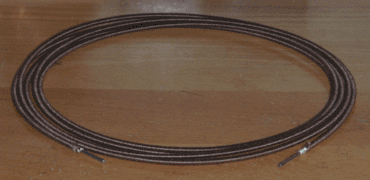
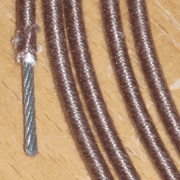
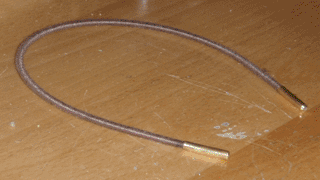
Although copper is the optimal conductive material for the vast majority of electrical applications, in the past I have found it lacking when used in flexible cords. When bent, copper tends to hold its shape; this eventually leads to lumps and wrinkles, particularly in power cords where thick copper is used. Furthermore, this constant bending and unbending fatigues the metal, causing fractures and intermittent contact within the cord. Steel, on the other hand, tends to maintain its original shape, and will not fatigue unless severely kinked. Despite its lower conductivity (roughly 1/6th that of copper), the potential for a wrinkle-free cord with an indefinite lifespan appealed to me, so I decided to make an insulated wire out of steel rope.
I began by developing an improved tensioner for the yarn spinning process. While simply tying the wire between two points is effective, it wastes significant material at the ends, and has a tendency to become loose over time. I improved on this by using a drill chuck mounted on a threaded rod to grip each end of the wire, with a wingnut to provide tension. This is used in conjunction with an L-shaped bracket, which can be clamped to a table or any other suitable surface for support. This can be seen below on the left.
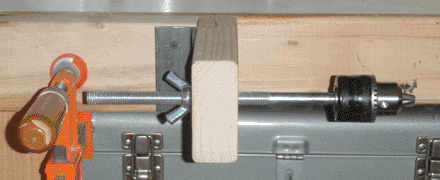
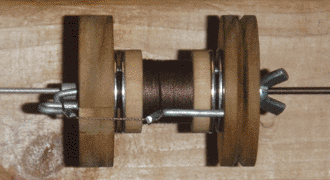
With this new fixture in place, I then covered an eight-foot length of 1/16" steel rope with two layers of insulation; the first being un-dyed cotton wrapped clockwise, and the second being brown cotton wrapped counter-clockwise. This reduces the usage of the more expensive dyed yarn, and provides contrast to distinguish the layers when the wire is cut. Both of these layers can be seen above on the right.
While the original steel rope was limp and flexible, once insulated it became fairly stiff, likely due to the compression of the strands by the insulation increasing the internal friction. However despite this, the wire still had the desirable property of not forming permanent wrinkles; it could be bent back and forth continually, with no apparent hardening or fatigue of the underlying metal. The insulation also performed well, with no separation or breakage of the yarn. As an additional test, I made a short jumper by soldering brass tubing to the ends of a section of wire. The cotton yarn withstood the heat well, and the galvanized steel rope could be soldered with rosin flux.
Overall I am pleased with the results here, although for a truly flexible wire I would either need to use thinner steel rope, or separate the strands from each other with padding or a lubricant. On the other hand, the double-layered insulation significantly exceeded my expectations; apparently during the winding process the two layers become felted together to a certain degree, and the strands of yarn must be physically picked apart to be unwound from the end when cut. This makes handling this type of wire no more difficult than handling modern plastic-insulated wire, and in fact the stripping process is actually easier. With some minor refinement and a suitable waterproof coating, this type of wire could easily become a staple of future projects.